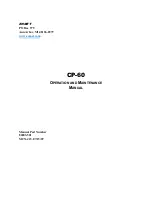
CP-60
ENMET
8
4.0 Operation
4.1 Normal Operation Condition
With the
CP-60
installed as described in Section 3, and in clean air, the
POWER
green LED is on, the display is lit, and the
information on the display is as shown in Figure 6, for the sensor(s) installed in the
CP-60.
The red alarm and fault LEDs are
not lit.
Example of display with Oxygen Channel 1, Hydrogen Sulfide Channel 2 and Methane Channel 3 Disabled.
Figure 6: CP-60
Operational Display
When the
CP-60
is first powered up, it goes through a series of momentary screens, which identify the instrument model number,
serial number and software revision. After all of the momentary screens have been displayed, the instrument arrives at the Main
Gas Display showing the gas concentration and unit of measurement in ppm, % or %LEL.
Depending on transmitter configuration and calibration condition, the furthest right character in the display may flash a letter
indicating the instrument status.
4.2 Alarm Conditions
There are two alarm set points available. These alarm points are normally set at established safety levels, such as the OSHA
Permissible Exposure Limit (PEL) for toxic gases or recognized standards below the Lower Explosive Limit for combustible
gases.
These alarm set points can be changed within limits; see the maintenance section of this manual for the procedure.
When the Oxygen, Toxic or combustible gas concentration reaches the alarm set point, the associated red LED is lit, the
associated relay changes state, and the audio alarm is activated
Pressing the
A
LARM
A
CKN
/A
UDIO
D
EFEAT
button can temporally disable the Audio Alarm. The horn will be disabled for
about five minutes. If a second alarm condition occurs during this time the horn will re-activate. If the alarm condition(s) have
ended during this time, the horn will not re-activate.
Differential Setting
Differential is an optional alarm relay configuration where when an alarm has been triggered, the relay will remain in alarm
state until the sensor reading has moved the differential “value” in the non-alarm direction. See example below.
The Alarm 1 differential value is the delay of the
CP-60
staying in alarm condition until after the measured reading has returned past the
alarm point by the differential value. Example: If the alarm point is
V
19.5 and the differential is 2, the
CP-60
will go into alarm at 19.5
and stay in alarm until the reading has risen above 21.5.
4.3 Alarm Latching
An instrument is shipped with the alarms in the latching mode. The alarms may be independently configured in the non-latching
mode or differential setting by use of the maintenance menu. See Section 5.2.2, for setting alarm 1 and alarm 2.
Standard Setting
I
N THE LATCHING MODE
: at the cessation of the condition which causes an alarm, the alarm indications do not cease, and the alarm relay
contacts do not revert to the non-alarm state, until the
ALARM ACKN/AUDIO DEFEAT
switch is pressed. An alarm can also be
acknowledged by pressing the switch during the alarm condition; then at the cessation of the alarm condition, alarm indications cease and
alarm relays revert to the non-alarm state. After an alarm is acknowledged, alarms in the latching configuration are re-armed to latch at the
next alarm condition.
I
N THE NON
-
LATCHING MODE
:
at the cessation of the condition that causes an alarm, the alarm indications automatically cease, and the alarm
relay contacts revert to the non-alarm state.
4.4 Audio Defeat
Pressing the
AUDIO DEFEAT
/
ALARM ACKNOWLEDGE
switch during an alarm temporarily silences the audio alarm on the
CP-
60
not on the sensor/transmitter. Relays and alarm LEDs continue to function, in the alarm state, during an alarm condition.
As long as the alarm condition persists, the audio alarm will “chirp” every 20 seconds. After the alarm condition clears, the
audio will continue to “chirp” until the audio switch is pressed.
If after 15 minutes the alarm condition continues the audio alarm will reactivate at full intensity.
If any other alarm condition occurs while the audio alarm has been silenced it will force the audio alarm to reactivate immediately
.
O2 20.9
Disabld
H2S 0
O
2
%
H
2
S
PPM
CH
4
%LEL
(
Transmitter 3
)
(
Transmitter 1
)
(
Transmitter 2
)
N
OTE
: Programmed Non-active channels
will display Disabled









































